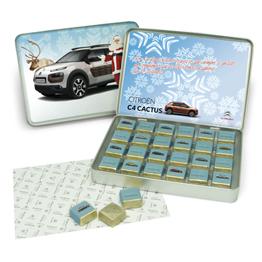
Advent calendars were first used in the 19th century by Protestants in Germany who simply made chalk lines on a door or other surface to count down the days until Christmas.
The first calendar he produced did not have windows. It had colored pictures attached to a piece of cardboard for each day of advent. Later, little doors were added to open each day for a religious picture or verse or a piece of candy.
The origins of calendario de adviento por navidad stretch back to seventeenth century Europe. They started off as simple chalk marks on a board to signify each day of advent, counting down to Christmas day, the celebration of the birth of Jesus Christ.
Calendars quickly became more elaborate with chalk marks replaced by pictures, or candles that were burned a small amount each day. In the mid nineteenth century the advent calendars we see today were first produced. They were made from two layers of card and had the recognizable numbered doors that are opened, one each day from December 1st to December 24th, Christmas Eve. This period also saw a move to more secular meaning, signifying for many the coming holiday season, with calendars having winter scenes rather than religious themes.
Many modern Advent Calendars are the traditional cardboard kind, but increasingly you can find many more unique variations. Some consist of a series of small drawers, each of which contains a tiny gift or a sweet treat for the day. Others involve one block being placed on a growing stack each day ultimately forming a Christmas design, or are made from materials such as fabric or wood. Another recent change has been the introduction of calendars that continue until New Year’s Eve. This was especially popular in 1999 as the new millennium approached.
One very popular type is the chocolate advent calendar. Calendario De Adviento De Chocolate were first seen in the 1950's, but their origins go back further. One of the earliest printed advent calendars started with the idea of little sweets being stuck on a cardboard backing. This was then adapted to pictures behind each door, which sometimes had candies in them as well. It is possible that this early idea of putting candies in the calendar lead to the more recent traditions of using chocolates.
As with all advent calendars, calendario de adviento have 24 doors that are opened as advent progresses. What makes them desirable to so many people is that behind each door, in addition to a picture or a verse, there is a chocolate in the shape of something associated with Christmas, such as a star, bell or Christmas tree.
The range of chocolate calendars is immense, some aimed at children with pictures on the front that reflect popular characters of the day, others at people with special dietary needs, including diabetics and people with nut and dairy allergies, or chocolate connoisseurs. Calendars for the chocoholic contain luxury chocolates that may be different flavors or contain a different filling each day. Luxury chocolate calendars tend to by expensive, some in excess of one hundred dollars, but they are a unique way to celebrate advent.
No matter what form an advent calendar takes, the common link between them all waiting, counting down and preparing for Christmas Day, whether your celebration will be religious or secular.

